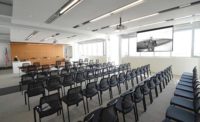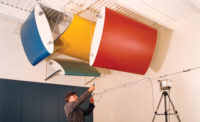10 Basic Acoustic Mistakes to Avoid
I’ve consulted on many types of projects, and it still amazes me that each project has its own unique acoustic character, unlike any other. Not one project has been a clone of another. Although the resulting designs are different, the acoustic problems to be solved remain the same. Some problems are designed into the building, some are caused by careless construction and still others are caused by the users of the building. In my experience, the following 10 basic acoustic mistakes are the most prevalent.
#1: Adding acoustic treatments after construction. Although buildings can be acoustically treated after construction, it is generally twice as expensive and half as effective when compared with designing the proper acoustics into the building. Ideally, the acoustic design of a building starts with site selection and building orientation to take advantage of the directionality of ambient noise and reduce the need for expensive sound isolation.
In any project, each wall, ceiling and component has an optimal sound transmission rating that will isolate the rooms from each other and from outside noise. If they are built with a lower rating, the building will not be suitable for the intended use; if they have a higher rating, the cost of the building will be greater than necessary. Counter to the common misconception that acoustic treatment is the application of materials on walls and ceilings, a major concern of acoustics is the initial, optimal selection of construction materials for cost-effective noise isolation and sound control.
#2: Using unbalanced noise barriers. A common waste of construction dollars is the use of unbalanced noise barriers. Simply put, the isolation of a room from outside noise is only as good as its weakest noise barrier. Typical mistakes are the construction of high STC-rated walls with hollow-core doors and standard windows. The premium paid for constructing the high STC walls is wasted money since noise enters through the doors and windows and the resulting background noise in the room is the same as if the walls had not been beefed up at all. The most cost-effective noise isolation solution is one in which each component has the same relative STC rating so that there is no weak link.
#3: Not sealing construction gaps. Sound always takes the easiest path around or through a barrier. Construction gaps are by far the easiest way for sound to pass from one room to the next. Mistakes range from the comical (e.g., not building a sound barrier wall all the way to the ceiling, plumbers and electricians hammering large access holes through sound barrier walls) to the typical (e.g., not sealing under and around drywall, not sealing electrical and plumbing penetrations). Sealing construction gaps is the easiest and least expensive method of improving the acoustics of all projects but it continues to be neglected by most contractors, who view the practice as an added time-consuming task that doesn’t add to the immediate appearance of the job.
#4: Bridging. Typical sound barriers are built so that the surface on one side of the barrier does not have a solid mechanical connection with the surface on the other side. This prevents the sound from easily telegraphing through the structure of the wall. Representative of this type of barrier is the stud wall in which the gypsum board on one side is mounted on resilient channel. This is a series of Z- or U-shaped metal extrusions that allow the board to move in and out very slightly from the stud wall. This freedom inhibits vibrations in the stud wall from reaching the board. The benefit of the channel can be quickly negated if just one of the drywall screws holding the board to the channel is driven too far. The overdriven screw bridges the acoustic gap between the board and stud wall, allowing most of the sound vibration through. Other bridges include sway bracing, common plates and common foundations.
#5: Problems with room shape. Basic architectural shapes that are problematic are (in order of difficulty) domes, round rooms, rooms with concave surfaces and cubical rooms. The problem with all of these shapes is their ability to focus reflected sound. The geometry of each of these shapes causes focal points and lines to form in space where reflections tend to arrive simultaneously. The simple solution is to destroy the acoustic symmetry of the space while maintaining its visual symmetry. This is done by treating the surfaces with diffusive and absorptive components.
#6: Adding mechanical noise. The largest source of unwanted noise in any building project is from its mechanical systems. HVAC air handlers and roof top units can be as loud as a rock band and therefore top the list of self-noise sources. HVAC systems designed for low noise use remotely located compressors, low fan speeds, low air velocities and long runs of ductwork with internal acoustic insulation. Projects quickly run into trouble when the mechanical contractor is asked to reduce the cost of such a system. The classic low-cost system uses self-contained RTUs mounted directly over the spaces they serve, short duct runs and high air velocities. Redesigning the building components to compensate for the increased noise can easily negate the savings in the HVAC system.
Other noise sources are smaller but can also exceed the desired background noise level of a room. These include high-intensity discharge lights, compressors in refrigerated drinking fountains, ballasts in fluorescent lighting, and transformers in exit signs. These noise sources can be eliminated by specifying equipment having the proper sound ratings.
#7: Painting over sound absorbers. Many high-frequency sound absorbers work as a function of their surface porosity. It is intuitively apparent that compressed fiberglass panels and cellulose fiber coatings work in this way and few people would question the fact that these surfaces should not be painted. Not so obvious (judging by the number of people that paint them) is the fact that suspended lay-in acoustic tile, acoustic plaster and concrete block should likewise not be painted. The miniscule pores in each of these materials allows sound to be absorbed into the material, changing sound energy to heat. Painting tends to close up these pores so that absorption cannot proceed. Actually, these surfaces can be painted but only with thinned, water-based paint and by those with enough experience to predict the result.
#8: Unbalanced sound absorption. Another common misconception, not helped by manufacturer’s reps, is that any room can be treated with the right amount of one product. The fact is that each acoustic material has absorption properties that vary with frequency and may not be appropriate in any amount in a particular room. The optimal acoustics of a space are determined over the entire frequency range as a function of its size and intended use. Any one acoustic treatment will likely only work over a small frequency range, and be unbalanced over the remaining bands. Optimal acoustics usually requires a combination of materials spread evenly throughout the room.
#9: Lack of diffusion. Even if the materials in a room have been carefully selected for optimal acoustics, a lack of diffusion can ruin the sound. Diffusion is the scattering of sound in all directions so that discrete reflections are not heard. Although discrete reflections can be produced by walls and ceilings in any space, the problem is usually noticed in small rooms with loud sources such as music practice rooms. The reflections from the room interfere with the musician’s ability to hear himself play. The solution is to add diffuser panels to the walls and ceilings of the room. These panels don’t absorb sound but rather reflect it in many directions.
#10: Noise-induced hearing loss. One acoustic mistake that can effect you personally is noise-induced hearing loss. According to government studies, about 15 to 20 percent of the workers in the building trades are exposed daily to noise high enough to cause permanent hearing loss. Power tools are the biggest sources of noise in this industry. Anyone exposed to more than 85 dBA for eight hours should be concerned. The duration that can be tolerated decreases with increasing source level. A level of 90 dBA can only be tolerated for two and a half hours, 95 dBA for 47 minutes, 100 dBA for 15 minutes, 105 dBA for four minutes, 110 dBA for one minute, 120 dBA for nine seconds and 130 dBA for less than one second. If you are in this category, you should be in a hearing-loss-prevention program. This program is a combination of education in the proper use of hearing-protection equipment and periodic hearing tests.
Hearing protectors include earmuffs, slow-recovery formable earplugs and other earplugs. Hearing protectors carry a noise reduction rating to rate their effectiveness. Because of the recent discovery that old laboratory tests do not simulate the fit of hearing protectors on real people, the National Institute for Occupational Safety and Health suggests that the real NRR ratings are only 75 percent of the labeled NRR for earmuffs, 50 percent of the labeled NRR for slow-recovery formable earplugs and only 30 percent of the labeled NRR for all other earplugs.
Looking for a reprint of this article?
From high-res PDFs to custom plaques, order your copy today!








